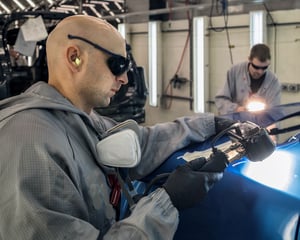
NHADA Loss Prevention to Conduct Noise Level Surveys
NHADA Loss Prevention will be conducting noise level surveys at NHADA members' facilities to determine the need to implement hearing protection policies.
PARTNER SPOTLIGHT
Dealer Management System, Computer Technology, Media/Advertising, Automotive Auction, F & I/Aftermarket Products, Automotive Technology Training & Compliance
 A NHADA Gold PARTNER
A NHADA Gold PARTNERComputer Technology, Automotive Shop Equipment, Environmental Services
 A NHADA Platinum PARTNER
A NHADA Platinum PARTNERF & I/Aftermarket Products, Automotive Technology Training & Compliance, Environmental Services
.png?width=150&name=corp_logo_horz_on_light_with_trademark_symbol_1200w%20(002).png) A NHADA Diamond PARTNER
A NHADA Diamond PARTNERAs part of the Personal Protection Equipment standards, OSHA requires employers to conduct hazard assessments to determine necessary PPE to safely do the job. NHADA Loss Prevention has conducted thorough hazard assessments and provides this information to members in the form of the PPE matrix.
Hearing protection has been identified as a needed addition to the PPE matrix. Originally it wasn’t incorporated because it has been a pretty well-known fact that the ambient background noise level in a typical repair shop is well below OSHA’s permissible level of 85 decibels (dB) averaged over an 8 hour period.
However, certain tasks generate considerable noise that may approach or exceed OSHA's permissible levels averaged over shorter periods. A prime example is the use of pneumatic air in the reconditioning department which can exceed 100 decibels. It is important to note that a 5-decibel increase represents a doubling of the noise level. This means that 95 dB is 200% louder than 85 dB. Below is a chart of OSHA permissible exposure levels:
85 dB avg 8 hours
90 dB avg 4 hours
95 dB avg 2 hours
100 dB avg 1 hour
105 dB avg .5 hour
NHADA Loss Prevention plans to contact NH Workwise Consultation Program for assistance with the sound surveys and will also perform surveys using a dosimeter app from NIOSH that allows you to use your phone.
The data will then be used to create a list of tasks that either require or recommend hearing protection along with the type and level of protection. This information will be added to the PPE matrix and be used to develop hearing protection policies similar to the task-specific eye protection policies most members have implemented.
The goal is to have this completed by summertime so we can begin to roll out the updated PPE matrix and policies to the members. If you are interested in having your shop surveyed, or have concerns related to noise levels contact Brian Duplessis at bduplessis@nhada.com.


















.png?width=150&name=Ally_Final%20Logos%20and%20Pairings_11.14.2018-01%20(2).png)


-2.png?width=150&name=Wipfli%20Logo%20Blue%20RGB%20(1)-2.png)


.jpg?width=150&name=NHADA_Partner_FTR_Img_NHADA_Insurance%20(1).jpg)


.jpg?width=150&name=NHADA_Partner_FTR_Img_JMA(1).jpg)




COMMENTS